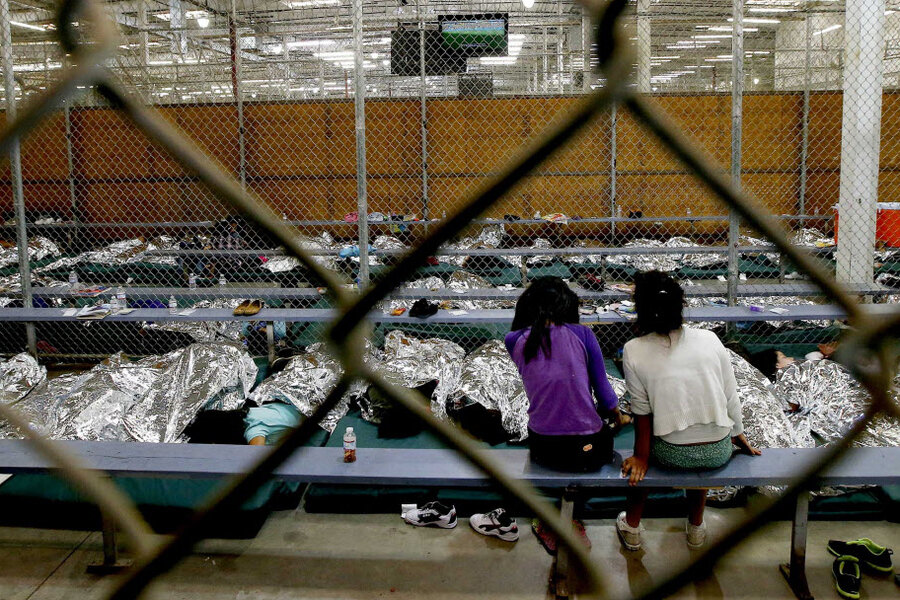For some migrant girls, rape and pregnancy are part of the journey
Loading...
| Tucson, Ariz.
Although teenage boys make up the bulk of Central American children traveling alone to the United States, girls increasingly are venturing north, too. And for some of them, the risky journey becomes even more difficult because of a pregnancy.
In some cases, girls are raped during their perilous trek. In other cases, sexual assault occurs before they leave, and that’s why they’re fleeing their home country.
Once these girls are in federal custody, their particular needs are factored in to the lengthy immigration proceedings.
Some of the girls, in fact, learn they are pregnant while undergoing medical screenings in US custody.
"A lot of the girls may suspect they're pregnant, but they don’t really know until they get that medical test," says Jennifer Podkul, an attorney and senior program officer for the Women's Refugee Commission in Washington, D.C.
About 35 percent of the 53,973 minors placed with the Department of Health and Human Services (HHS) since Oct. 1 are girls, according to that agency, which is tasked with providing care for the unaccompanied minors.
In the fiscal year that began Oct. 1, 2012, underage pregnant girls in federal custody gave birth to 50 children, wrote Kenneth Wolfe, an HHS spokesman, in an e-mail.
The young mothers are part of the influx of youths from Guatemala, El Salvador, and Honduras who are illegally entering the US and doing so without a parent or guardian. The influx, which actually began in 2011 after years of steady flows, has strained the immigration system and prompted debate across the country about how to handle the children.
While unaccompanied minors trying to cross the US-Mexico border often confront physical and emotional trauma along the way, girls can be particularly vulnerable to sexual violence by individuals and criminal organizations.
Oftentimes, such violence happens before the girls head north, says Ms. Podkul, who has represented minors in court and interviewed many for a report on migrant children arriving in the US.
"There's everything from stories of incest to rape by gang members," she says. "Rape is being used as a tool by these gangs to exert control."
In Guatemala alone, thousands of adolescents are sexually abused each year, mostly by relatives, according to human rights groups in that country.
Others become victims on their way to the US. Podkul remembers the case of a 15-year-old Guatemalan who was held captive in Mexico for several months by a drug trafficker.
"She had to stay in his safehouse and have sex with him whenever he wanted to," she says.
According to Podkul, a guard at the house eventually took pity on the girl and allowed her to continue her US-bound trip. She ended up in detention, and there, the teen found out she was pregnant.
Indeed, detention – by border patrol – is what happens when the girls cross the border. But once they are placed in federal custody, their needs can begin to be addressed.
Child protection advocates are assigned to the girls, and the advocates meet with them once a week while they’re in federal custody, says Maria Woltjen, director of the Young Center for Immigrant Children's Rights at the University of Chicago Law School.
However, "it takes a fair amount of time before they disclose that something happened to them on the journey here – or in the home country, for that matter, " Ms. Woltjen says.
Early on, pregnant girls live in a foster home setting and have access to prenatal care, counseling, lawyers, and social workers.
Once the girls give birth, HHS "works very hard to identify family so that the girl and her child can be living with a caring, loving family member while they're going through their immigration proceedings," Woltjen says.
The girls’ legal fate, like others’, rests in the hands of immigration courts. A determination on whether an unaccompanied minor can stay in the country legally often takes years.
In the report that Podkul cowrote in 2012, children described intense fears of being killed, kidnapped, or beaten during trips that could last several weeks. Some talked of being locked up for days in rat-infested warehouses. One youngster recounted "how women and girls were kept in a separate room and could be heard screaming while being raped."
Many female travelers are well aware of the perils.
"People talk about it very frankly and are very open about it, trying to get on birth control before they make the journey," Podkul says.
Homeland Secretary Jeh Johnson testified as much before members of Congress in July, saying that parents give contraceptives to their daughters "in case they're raped along the way."
He spoke of meeting with youths, including a 15-year-old girl who was three months pregnant, at a temporary detention center in Nogales, Ariz. From May 31 to July 22, authorities processed 5,479 unaccompanied children from Central America there, and some of the children had children of their own.
But not all Central American parents should be blamed for their children’s departure to the US, Podkul says. "A lot of these kids, girls and boys, are actually making the decision on their own," she says.
For many Americans, the arrival of children to the US without parents, including pregnant girls and underage mothers, may come as a shock. But Juanita Molina, executive director of the Border Action Network in Tucson, Ariz., a human rights group, views it as a continuation of longtime migration patterns that ebb and flow.
"The volume of children coming through changed the emotional landscape," she says. "But the reality is that these issues have been going on for years."







